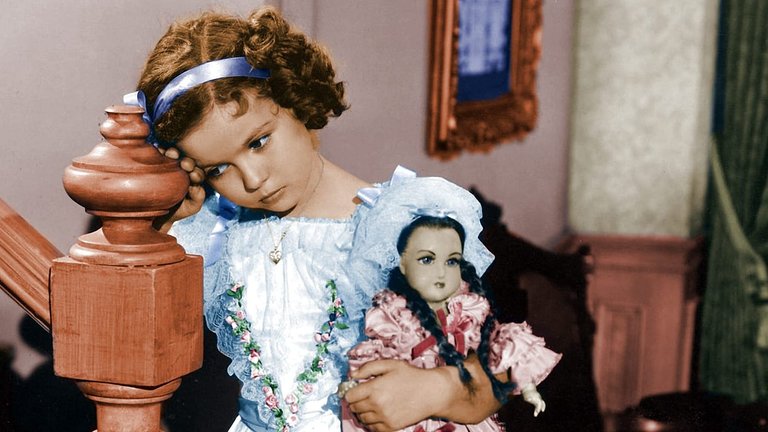Film Review: The Little Princess (1939)

Certain films from Classic Hollywood can be properly enjoyed and appreciated only with some knowledge of history; yet that exact same knowledge of history can, at the same time, spoil that very enjoyment. The 1939 film The Little Princess is a prime example of this strange phenomenon.
The film is based on A Little Princess, a 1905 novel by Frances Hodgson Burnett. The plot is set in 1899 London and follows Sara Crewe (played by Shirley Temple), a young girl sent to a boarding school in London by her wealthy father, Captain Crewe (played by Ian Hunter), while he fights in the Second Boer War. Sara's kind nature and vivid imagination make her a favourite among her classmates and teachers, but when news arrives that her father has died and left her penniless, school’s owner Miss Michin (played by Mary Nash) forces to work as a servant in the school. Despite her hardships, Sara never loses hope and continues to dream of her father's return.
The Little Princess was made at a time when Hollywood was building its projects around their stars, and Shirley Temple, who was around ten years old at the time, was by all measurements Hollywood's most popular star and among the most legendary child actors in the entire history of cinema. The simple plot and sentimentality of the film seemed tailor-made for her. Daryl F. Zanuck, head of 20th Century Fox, brought a great budget for the film, most of which was spent on Technicolor, a new, clumsy, and expensive technology that allowed Temple to star in her first colour film. Due to children's greater sensitivity, technicians and engineers developed new and less harmful methods of studio lighting necessary for the colour cinematography process. Apart from colour, the high budget can also be seen in the meticulous reconstruction of late Victorian London, not only through studio sets but also through authentic costumes and props.
The story from the original novel is further enhanced by elements that would appeal to as big an audience as possible – a romantic subplot involving Sara's teachers, played by Richard Greene and Anita Louise, as well as the casting of Arthur Treacher as Bertie Minchin, a character of Minchin’s kind-hearted brother, introduced as former music hall entertainer, which allowed Temple to perform with him in a short but delectable dance and song number "Old Kent Road." There is even a fantasy scene that served as a perfect excuse for a charming ballet sequence.
Like with many of her hits based on popular works of children's literature, Shirley Temple had some big shoes to fill, in this particular case Mary Pickford, who had, despite being an adult, played the same role in the 1917 silent film The Little Princess. Temple delivered a great performance, resulting in a film that is, thanks to colour, the most accessible to modern audiences. She easily overshadows most other members of the cast, with the possible exception of Treacher and Sybil Jason, a child actress playing school’s servant Becky, who, despite being touted by Warner Bros. studio as Temple's rival, became her good friend both on and off screen.
Yet, there is one dark shadow that hangs over the film. The motive of the Second Boer War, which is used in the film, didn't exist in the original novel. Here, it is present not only in British patriotic songs and marches that complement the soundtrack but also through the heart-breaking motive of the protagonist's missing father and Sara's seemingly futile attempt to find him by visiting a military hospital. In a scene that was probably the most disturbing, one of the interviewed soldiers displays clear symptoms that today's audience would recognize as "post-traumatic stress disorder." The dark content becomes even darker considering that only six months after the premiere, Britain became involved in the Second World War, and millions of real-life Saras experienced similar, if not worse, ordeals in a conflict much more devastating than anyone had imagined. Yet, this darkness is, to a degree, compensated for by an almost fairytale happy ending that would, depending on the audience's mood, either be enthusiastically greeted or seen as typical Hollywood escapism.
The original novel later served as the basis for at least three major adaptations in the 1990s – the 1995 Hollywood version A Little Princess starring real-life heiress Leslie Matthews and directed by Mexican director Alfonso Cuaron in his Hollywood debut, the 1995 Filipino film Sarah... Ang Munting Prinsesa starring Camille Pratts, and the 1997 Russian film starring Nastya Meskova.
The Little Princess is a bittersweet cinematic gem that showcases Shirley Temple's talent and the power of storytelling to transcend time and culture. While the film may be seen as a product of its era, it also serves as a poignant reminder of the resilience of the human spirit in the face of adversity.
RATING: 7/10 (+++)
Blog in Croatian https://draxblog.com
Blog in English https://draxreview.wordpress.com/
InLeo blog https://inleo.io/@drax.leo
Hiveonboard: https://hiveonboard.com?ref=drax
Rising Star game: https://www.risingstargame.com?referrer=drax
1Inch: https://1inch.exchange/#/r/0x83823d8CCB74F828148258BB4457642124b1328e
BTC donations: 1EWxiMiP6iiG9rger3NuUSd6HByaxQWafG
ETH donations: 0xB305F144323b99e6f8b1d66f5D7DE78B498C32A7
BCH donations: qpvxw0jax79lhmvlgcldkzpqanf03r9cjv8y6gtmk9
Posted Using InLeo Alpha
I find it a very interesting film with a quite touching plot. I'm intrigued by that mix of fantastic and realistic elements, and how they manage to balance it. It sounds like a film that manages to touch the heart despite the difficult times it evokes. 👍